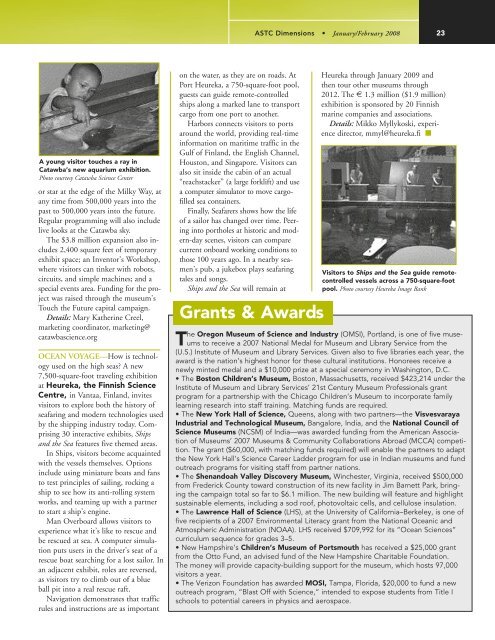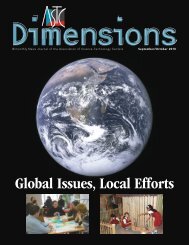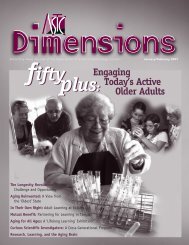Scientists Speak about Nano - Association of Science - Technology ...
Scientists Speak about Nano - Association of Science - Technology ...
Scientists Speak about Nano - Association of Science - Technology ...
Create successful ePaper yourself
Turn your PDF publications into a flip-book with our unique Google optimized e-Paper software.
A young visitor touches a ray in<br />
Catawba’s new aquarium exhibition.<br />
Photo courtesy Catawba <strong>Science</strong> Center<br />
or star at the edge <strong>of</strong> the Milky Way, at<br />
any time from 500,000 years into the<br />
past to 500,000 years into the future.<br />
Regular programming will also include<br />
live looks at the Catawba sky.<br />
The $3.8 million expansion also includes<br />
2,400 square feet <strong>of</strong> temporary<br />
exhibit space; an Inventor’s Workshop,<br />
where visitors can tinker with robots,<br />
circuits, and simple machines; and a<br />
special events area. Funding for the project<br />
was raised through the museum’s<br />
Touch the Future capital campaign.<br />
Details: Mary Katherine Creel,<br />
marketing coordinator, marketing@<br />
catawbascience.org<br />
OCEAN VOYAGE—How is technology<br />
used on the high seas? A new<br />
7,500-square-foot traveling exhibition<br />
at Heureka, the Finnish <strong>Science</strong><br />
Centre, in Vantaa, Finland, invites<br />
visitors to explore both the history <strong>of</strong><br />
seafaring and modern technologies used<br />
by the shipping industry today. Comprising<br />
30 interactive exhibits, Ships<br />
and the Sea features five themed areas.<br />
In Ships, visitors become acquainted<br />
with the vessels themselves. Options<br />
include using miniature boats and fans<br />
to test principles <strong>of</strong> sailing, rocking a<br />
ship to see how its anti-rolling system<br />
works, and teaming up with a partner<br />
to start a ship’s engine.<br />
Man Overboard allows visitors to<br />
experience what it’s like to rescue and<br />
be rescued at sea. A computer simulation<br />
puts users in the driver’s seat <strong>of</strong> a<br />
rescue boat searching for a lost sailor. In<br />
an adjacent exhibit, roles are reversed,<br />
as visitors try to climb out <strong>of</strong> a blue<br />
ball pit into a real rescue raft.<br />
Navigation demonstrates that traffic<br />
rules and instructions are as important<br />
on the water, as they are on roads. At<br />
Port Heureka, a 750-square-foot pool,<br />
guests can guide remote-controlled<br />
ships along a marked lane to transport<br />
cargo from one port to another.<br />
Harbors connects visitors to ports<br />
around the world, providing real-time<br />
information on maritime traffic in the<br />
Gulf <strong>of</strong> Finland, the English Channel,<br />
Houston, and Singapore. Visitors can<br />
also sit inside the cabin <strong>of</strong> an actual<br />
“reachstacker” (a large forklift) and use<br />
a computer simulator to move carg<strong>of</strong>illed<br />
sea containers.<br />
Finally, Seafarers shows how the life<br />
<strong>of</strong> a sailor has changed over time. Peering<br />
into portholes at historic and modern-day<br />
scenes, visitors can compare<br />
current onboard working conditions to<br />
those 100 years ago. In a nearby seamen’s<br />
pub, a jukebox plays seafaring<br />
tales and songs.<br />
Ships and the Sea will remain at<br />
Grants & Awards<br />
ASTC Dimensions • January/February 2007 23<br />
ASTC Dimensions • January/February 2008 23<br />
Heureka through January 2009 and<br />
then tour other museums through<br />
2012. The € 1.3 million ($1.9 million)<br />
exhibition is sponsored by 20 Finnish<br />
marine companies and associations.<br />
Details: Mikko Myllykoski, experience<br />
director, mmyl@heureka.fi ■<br />
Visitors to Ships and the Sea guide remotecontrolled<br />
vessels across a 750-square-foot<br />
pool. Photo courtesy Heureka Image Bank<br />
The Oregon Museum <strong>of</strong> <strong>Science</strong> and Industry (OMSI), Portland, is one <strong>of</strong> five museums<br />
to receive a 2007 National Medal for Museum and Library Service from the<br />
(U.S.) Institute <strong>of</strong> Museum and Library Services. Given also to five libraries each year, the<br />
award is the nation’s highest honor for these cultural institutions. Honorees receive a<br />
newly minted medal and a $10,000 prize at a special ceremony in Washington, D.C.<br />
• The Boston Children’s Museum, Boston, Massachusetts, received $423,214 under the<br />
Institute <strong>of</strong> Museum and Library Services’ 21st Century Museum Pr<strong>of</strong>essionals grant<br />
program for a partnership with the Chicago Children’s Museum to incorporate family<br />
learning research into staff training. Matching funds are required.<br />
• The New York Hall <strong>of</strong> <strong>Science</strong>, Queens, along with two partners—the Visvesvaraya<br />
Industrial and Technological Museum, Bangalore, India, and the National Council <strong>of</strong><br />
<strong>Science</strong> Museums (NCSM) <strong>of</strong> India—was awarded funding from the American <strong>Association</strong><br />
<strong>of</strong> Museums’ 2007 Museums & Community Collaborations Abroad (MCCA) competition.<br />
The grant ($60,000, with matching funds required) will enable the partners to adapt<br />
the New York Hall’s <strong>Science</strong> Career Ladder program for use in Indian museums and fund<br />
outreach programs for visiting staff from partner nations.<br />
• The Shenandoah Valley Discovery Museum, Winchester, Virginia, received $500,000<br />
from Frederick County toward construction <strong>of</strong> its new facility in Jim Barnett Park, bringing<br />
the campaign total so far to $6.1 million. The new building will feature and highlight<br />
sustainable elements, including a sod ro<strong>of</strong>, photovoltaic cells, and cellulose insulation.<br />
• The Lawrence Hall <strong>of</strong> <strong>Science</strong> (LHS), at the University <strong>of</strong> California–Berkeley, is one <strong>of</strong><br />
five recipients <strong>of</strong> a 2007 Environmental Literacy grant from the National Oceanic and<br />
Atmospheric Administration (NOAA). LHS received $709,992 for its “Ocean <strong>Science</strong>s”<br />
curriculum sequence for grades 3–5.<br />
• New Hampshire’s Children’s Museum <strong>of</strong> Portsmouth has received a $25,000 grant<br />
from the Otto Fund, an advised fund <strong>of</strong> the New Hampshire Charitable Foundation.<br />
The money will provide capacity-building support for the museum, which hosts 97,000<br />
visitors a year.<br />
• The Verizon Foundation has awarded MOSI, Tampa, Florida, $20,000 to fund a new<br />
outreach program, “Blast Off with <strong>Science</strong>,” intended to expose students from Title I<br />
schools to potential careers in physics and aerospace.





